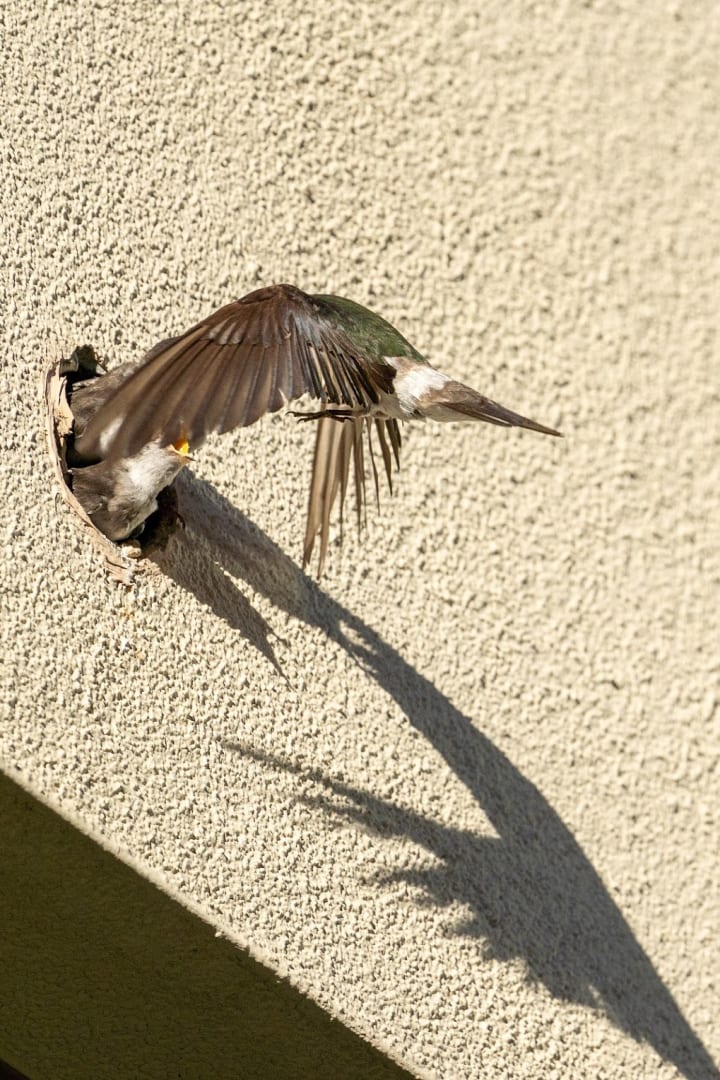What The Swallows Know
a long day spent observing one family of local birds gave me insight into the secret worlds of my hometown

In her newest book, Rising Strong, author and resiliency researcher Brené Brown quotes a proverb she learned from the Asaro tribe of Indonesia and Papua New Guinea:
“Knowledge is only a rumor until it lives in the body.”
Before quarantine, I thought I knew where I lived. I knew how to get around my neighborhood. I recognized the local flora and fauna when I wandered by - ravens and squirrels and the occasional stray cat. I knew some general history of the area.
But that knowledge didn’t live in my body. It was vague, cerebral.
Then, my world contracted. After countrywide lockdown and stay at home orders took effect in early 2020, the boundaries of my daily life shrunk to include only my small apartment and the courtyard outside its door. And I realized just how much knowledge I had previously been missing.
When you sit in one place long enough, your body starts to discover what it means to truly be there. You begin to hear that the sounds you once tuned out as background noise contain secret languages, and you start to understand what they might mean. You step into the private routines of sunbeams and birdsong, which manage their own days according to a complex and subtle rhythm.
None of this is hidden. It’s always been there, easily observable for anyone willing to observe. It’s that willingness, the stillness and patience necessary to allow the knowledge of a place to seep into your body where it can become truly known, that’s the hard part.
But quarantine gave me no choice but to slow down and stay in one place for long enough to really get to know it. By mid-summer, I’d grown especially interested in the native birds that hopped, chirped, and perched all around my apartment building. I could tell exactly when the local stray cat was visiting by the warning calls the sparrows made, and where she was hiding based on where specific “lookout” birds were stationed.
I learned that the ravens on my street had an efficient method for flipping over a discarded bag to check whether it still had food inside it. I could predict the appearance of a single hummingbird that preferred to visit a specific flowering tree around 3:30 in the afternoon, when it was hit most directly by the sun.
Best of all, I discovered that a family of Violet-Green Swallows had built a nest in the stucco wall of the complex, and in late spring, they hatched a clutch of three babies. In any normal year, I never would have known they were there, but the slow, quiet, almost meditative state that quarantine forced onto all of us meant I was able to notice the adult birds visiting the nest for feeding, then hear the soft “cheeps” the babies made to communicate with them.

I went to take a picture of the birds, but quickly found that they were nearly impossible to photograph without a lot of careful, painstaking attention.
Fortunately for me, that was a resource I had in abundance. In fact, it was the only reason I’d even become aware of their presence in the first place.
So I set about watching the birds and their babies, learning the patterns of their behavior so that I could predict the exact moment when I could get a picture that wasn’t just some grey blurs against a stucco background.
Most of the time, the babies sit back in their little nest, which is almost a tube-shaped hole set into the wall. They don’t hide away completely, though - they peek out just barely, keeping an eye on the outside world without being too noticeable. During this stage, they make some noise, but it’s more of a “status update” cheep, sporadic and quiet.

At some point, they sense a parent bird approaching, and perk up. At this point, they’re not hiding - they’re waiting. They remain tucked inside the nest, but they’re keyed up, cheeping more insistently now.
After a few seconds of this, they adjust themselves in preparation for an incoming parent carrying food. They are tense, ready, alert. This change in the babies’ behavior was my signal that I needed to raise my camera and start getting it focused, because the parent would be approaching and feeding the babies within about thirty seconds.

Most of the action happens within a few short instants. When the parent bird begins his or her finally approach, the babies stick their heads as far out of the nest as they can, opening their beaks wide, and cheeping aggressively and loudly. They even shove and jostle each other with their necks to get the best position, since only one baby gets fed on each parental visit.

The adult bird does one final loop around the area to make sure it’s safe, then flies straight at the nest until they almost crash into it. They throw their wings backwards to stall up against the wall, then bend their head down to feed the luckiest chick. This entire process takes less than a second, and the adult bird never really stops moving.

To me, a human, the sight was strange and fascinating. Before this experience, I’d never taken the time to witness, let alone try to understand, exactly how a bird feeds its babies. Now, I can describe each step of the process and the avian body language that accompanies it. I know how a baby bird communicates that it would very much like to be fed, and I know how an adult bird maneuvers its wings to bring food to a nest quickly and safely without landing.
But to the birds, this was entirely mundane. It’s something they do every day when their babies are young. Every year, in the spring, millions of Violet-Green Swallows do the same thing. For generations, their ancestors did the same thing. The precise wing movements, the shifting meanings behind the different variations on cheeping noises, the safety check before coming in to feed - it’s knowledge that lives in the bodies, the bones and beaks, of the Violet-Green Swallow.

If I took one lesson from the bizarre experience of 2020 and the pandemic related quarantine, it’s that every tiny corner of the world is brimming with knowledge. No matter where you are, whether your hometown is an urban jungle of concrete and rebar, or a sleepy suburban landscape of stucco and sidewalks, there’s a whole drama playing out all around you. Everything from insects to municipal installations has its own private life, and it’s there to be shared.
You don’t need a camera, or quarantine, or a nest of baby birds to give you a reason to take the time to puzzle out what you’re really seeing. If we want to know what’s going on around us, we just need to be open to that knowledge and willing to sit in stillness and curiosity long enough to let understanding settle in. You already live in your hometown - now let its knowledge live in you.
About the Creator
Lacey Doddrow
hedonist, storyteller, solicited advice giver, desert dweller








Comments
There are no comments for this story
Be the first to respond and start the conversation.